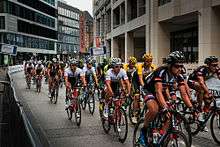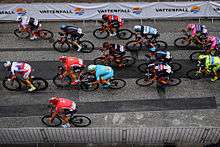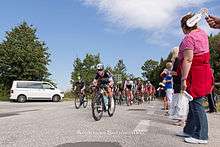EuroEyes Cyclassics
The EuroEyes Cyclassics, formerly HEW Cyclassics and Vattenfall Cyclassics, is an annual one-day professional and amateur cycling race in and around Hamburg, Germany. Although the route varies, its distance is always around 250 km. The course's most significant difficulty is Waseberg hill in Blankenese, which is addressed three times in the race finale.[1]
 | |
| Race details | |
|---|---|
| Date | Mid to late August |
| Region | Hamburg, Germany |
| Discipline | Road |
| Competition | UCI World Tour |
| Type | Single-day race |
| Web site | www |
| History | |
| First edition | 1996 |
| Editions | 24 (as of 2019) |
| First winner | |
| Most wins | |
| Most recent | |
Until 2016 it was Germany's only event on the UCI World Tour calendar, before the inclusion of Eschborn-Frankfurt – Rund um den Finanzplatz in 2017. The race is organized by IRONMAN Unlimited Events Germany GmbH, which also organizes the annual Velothon Berlin.
An important part of the Cyclassics is the Jedermannrennen ("Everyman's race"), an amateur/cyclosportif event held on the same day and on the same roads as the professional race. Bike fanatics can participate in amateur tour races over 55 km, 100 km and 155 km.[2] The number of participants is limited to 22.000 amateurs and tickets must be reserved months in advance.[3]
History
HEW Cyclassics

The event was created in 1996 as a 1.5 race, the lowest classification of professional races. The first edition was its shortest ever, totaling just 160 km, won by Italian Rossano Brasi.[4] HEW, Hamburg's Electricity Works, served as the race's title sponsor. In 1997 Jan Ullrich won the second edition amid hordes of fans, two weeks after winning the Tour de France, and the race gained prestige fast.[5]
With cycling's fast-growing popularity in Germany in the 1990s, the race became part of the UCI Road World Cup in 1998, cycling's ten highest-classified one-day races. It replaced the Wincanton Classic, Britain's only cycling classic, as the seventh leg of the World Cup.[6] Dutchman Leon van Bon outsprinted Michele Bartoli to win the third edition; the distance was increased to 253 km.
Erik Zabel was the second German winner of the HEW Cyclassics in 2001.[7][8] In 2002, Belgian classics specialist Johan Museeuw won his eleventh and last World Cup race, leading out the sprint from a group of ten.[9]
Vattenfall Cyclassics

In 2002, race sponsor HEW was overtaken by Swedish electricity conglomerate Vattenfall and was renamed Vattenfall Europe Hamburg. Vattenfall, Swedish for Waterfall, became the race's new title sponsor in 2006. In 2005, the race was included in the inaugural UCI ProTour, successor of the World Cup. After the disappearance of the Deutschland Tour in 2009, it remained the only German race at cycling's highest international level.[10] Since 2011 it is one of 24 races of the UCI World Tour. In 2012, UCI extended the race's World Tour license until at least 2016.[11]
Because of its mostly flat course, the race is considered a sprinter's contest and has ended in a mass sprint uninterrupted since 2004. Some of the best sprinters of their generation, including Robbie McEwen, Óscar Freire, Alexander Kristoff and André Greipel, are among the winners of the race. American sprinter Tyler Farrar, winner of the 2009 and 2010 Cyclassics, is the only rider to have won the race two times.[12]
The 2013 race was met with fierce protesting unrelated to the race. Hamburg residents were upset with Vattenfall's environmental policies and its attempts to acquire ownership of the local power grid.[13]
EuroEyes Cyclassics
In 2015 it was announced that Vattenfall would not extend its partnership with the Hamburg Cyclassics, forcing organizers to search for a new sponsor to provide the estimated 800.000 Euro, a third of the race's budget.[14] Since 2016 EuroEyes, a large German provider of laser eye treatment, Femto-LASIK, lens surgeries, and refrative lens exchanges, is the new title sponsor.[15] Australian sprinter Caleb Ewan won the race after the initial winner, Nacer Bouhanni, was relegated.[16]
Route

The race usually starts on the Steinstraße in Hamburg-Altstadt and finishes on Mönckebergstraße, Hamburg's illustrious shopping street in the city's busy commercial district. The distance varies from 225–255 km over mainly flat terrain in the hinterland of Hamburg. The route of the race undergoes some changes every year, but the finish location has remained the same throughout.
.jpg)
The course's most significant difficulty is Waseberg hill in Blankenese, a suburban quarter of Altona, west of Hamburg's city centre. The race finale consists of three smaller laps west of Hamburg, containing the Waseberg. It is first climbed at 69 kilometres (42.9 mi) from the finish, the second and third ascent are at 28 kilometres (17.4 mi) and 15.5 kilometres (9.6 mi) respectively.[1]
The Waseberg is a steep asphalted hill running up from the north bank of the Elbe river into the suburban centre of Blankenese. Its length is 700 m with a maximum gradient of 16%. It is particularly challenging as the climb immediately follows a sharp curve, causing an abrupt change in gear and cadence. As teams try to position their captains in the front of the peloton, riders often rush furiously over the narrow roads leading to the foot of the climb.[17] The route also includes the Köhlbrandbrücke, Hamburg's highest bridge.
From 2005 until 2014 the first half of the course consisted of a southern loop in the direction of Lüneburg Heath in Lower Saxony, before returning to the centre of Hamburg and branching out to a western loop.[18]
In 2015 organizers changed the parcours to celebrate the twentieth edition of the race.[19] The race started in Kiel, 90 kilometers north of Hamburg, on the western shore of the Baltic Sea, before heading southwest to Hamburg, crossing Schleswig-Holstein. The total distance was shortened to 222 kilometres (137.9 mi), but the final approach into Hamburg, with three ascents of the Waseberg and the finish on the Mönckebergstraße, remained the same.[1][N 1] The route from Kiel to Hamburg was also chosen to promote the cities' joint bid to host the 2024 Summer Olympics.[20]
Race director Roland Hofer said of the course: "Although the race profile may appear more suitable for sprinters, it can ultimately be won by all types of great riders, and it is exactly this kind of race that is needed for a well-balanced World Tour event [...] The World Tour came to Germany in the midst of a "renaissance" of German cycling, with the latest successes rejuvenating the country's interest in the sport after a setback during the past, doping stricken years."[21]
Winners




Multiple Winners
| Wins | Rider | Editions |
|---|---|---|
| 2017 + 2018 + 2019 | ||
| 2009 + 2010 |
Wins per country
| Wins | Country |
|---|---|
| 9 | |
| 4 | |
| 3 | |
| 2 | |
| 1 |
Notes
- Note that the source from cyclingquotes.com erroneously names Cologne as the starting location of the race.
References
- Axelgaard, Emil (23 August 2015). "Vattenfall Cyclassics preview". cyclingquotes.com. Retrieved 12 September 2015.
- "Vattenfall Cyclassics". Jedermanntermine (in German). Retrieved 3 December 2015.
- "Mehr als 15 000 Jedermann-Fahrer in Hamburg". T-Online (in German). Archived from the original on 8 December 2015. Retrieved 3 December 2015.
- "Tour of Hamburg, Germany". autobus.cyclingnews.com. CyclingNews. Retrieved 25 November 2015.
- "HEW-Cyclassics Cup, Cat 1.5". cyclingnews.com. CyclingNews. Retrieved 25 November 2015.
- "HEW-Cyclassics Cup, World Cup Round 7". autobus.cyclingnews.com. CyclingNews. Retrieved 25 November 2015.
- Jones, Jeff. "HEW-Cyclassics - CDM Hamburg, Germany, August 19, 2001". autobus.cyclingnews.com. CyclingNews. Retrieved 25 November 2015.
- Jones, Jeff. "Perfect finish for Zabel". autobus.cyclingnews.com. CyclingNews. Retrieved 25 November 2015.
- Jones, Jeff. "News for August 5, 2002. HEW Cyclassics wrap up". autobus.cyclingnews.com. CyclingNews. Retrieved 26 November 2015.
- "No Deutschland Tour in 2011 McQuaid supports return of German stage race". cyclingnews.com. CyclingNews. Retrieved 25 November 2015.
- "Cyclassics auch die nächsten Jahre Elite-Rennen". www.rad-net.de. Rad-Net. Retrieved 25 November 2015.
- "Vattenfall Cyclassics 2010: Tyler Farrar outsprints Edvald Boasson Hagen in Hamburg". www.telegraph.co.uk. Telegraph staff and agencies. Retrieved 25 November 2015.
- "Tschüss Vattenfall - Kletterprotest im Zielbereich der Cyclassics" (in German). Tschüss Vattenfall. Retrieved 13 September 2013.
- Leoni, Achim (22 August 2015). "Kein Hauptsponsor mehr: Was wird aus den Cyclassics?" (in German). Hamburger Abendblatt. Retrieved 11 September 2015.
- http://cyclassics.euroeyes.de/
- "Ewan wins Cyclassics Hamburg after Bouhanni is relegated". cyclingnews.com. Retrieved 3 September 2016.
- Axelgaard, Emil. "Vattenfall Cyclassics preview 24.08.2014". cyclingquotes.com. CyclingQuotes. Retrieved 26 November 2015.
- "Vattenfall Cyclassics preview August 23, 2014". velovoices.com. VeloVoices staff. Retrieved 25 November 2015.
- O'Shea, Sadhbh. "Cavendish, Kittel and Greipel match-up in German WorldTour race. 20th edition suits Germany's best riders". cyclingnews.com. CyclingNews. Retrieved 25 November 2015.
- "André Greipel, Marcel Kittel und Tony Martin: Deutsche Topstars starten in Hamburg" (in German). Eurosport. 26 November 2015. Retrieved 11 September 2015.
- "Vattenfall Cyclassics". UCI. Retrieved 11 September 2015.
- "Cyclassics Hamburg cancelled due to coronavirus". cyclingnews.com. 20 July 2020. Retrieved 20 July 2020.
External links
| Wikimedia Commons has media related to Cyclassics Hamburg. |
- Official website
- EuroEyes Cyclassics palmares at Cycling Archives